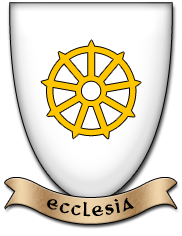Difference between revisions of "Category:Imperial Church of the Pantheon"
(→Crusader Order) |
|||
| Line 1: | Line 1: | ||
| − | [[ | + | [[File:Arms-ecclesia.png|right]] |
| − | |||
=Details= | =Details= | ||
Ruler: [[Sonorus|Pontiff Sonorus]], with the Conclave<br> | Ruler: [[Sonorus|Pontiff Sonorus]], with the Conclave<br> | ||
| Line 19: | Line 18: | ||
= Locations = | = Locations = | ||
| + | [[Image:Fgle-holycity.jpg|right|300px|thumb|The Holy City, Ecclesia]] | ||
*The Holy City in Ecclesia | *The Holy City in Ecclesia | ||
*Archdistricts (per Duchy; =archdiocese) | *Archdistricts (per Duchy; =archdiocese) | ||
Revision as of 05:26, 15 December 2020
Contents
Details
Ruler: Pontiff Sonorus, with the Conclave
Seat: The Holy City, Ecclesia
Symbol: a 9-spoked wheel
Tropes
Crystal Dragon Jesus: Modified (Polytheistic)
Perception
Origin and History
- Began as a splinter-cult out of the old, traditional forms of worship
- Officially recognized by the Old Empire 1500ya
- Very old rivalry with the Druids for influence
- Schism in the Old Empire at the formation of the Church regarding the worship of the whole Pantheon in the same temple (polytheism vs henotheism); the church in Tyrantium still follows the old way, and does not recognize the Pontiff
- Ecclesia gifted to the Church by Überland
Locations
- The Holy City in Ecclesia
- Archdistricts (per Duchy; =archdiocese)
- Districts (per County; =diocese)
- Patronships (per Holding; =parish)
- Abbeys
- Priorys
- Holy Sites
Ranks
- His Holiness, Pontiff X; =Pope
- His Eminence, Heirant X, Archvicar of X; =Cardinal
- His Grace, Archvicar X, Archvicar of X; =Archbishop
- His Lordship, Vicar X, (Lord) Vicar of X; =Bishop
- Patron/Matron X, Patron/Matron of X; priest
- Brother/Sister X; members of religious orders under vows (both monastic and non-monastic) who are not priests
Brothers-Militant
- Brothers taking up arms to protect the helpless—Church's version of the Heroes' Guild (and easy way to get troublesome lay-brothers out of the way)
Practices
See the Pantheon
Unlike the old ways, whose worshipers are looked down upon by members of the Imperial Church as unrefined, the Faith is based on a number of holy texts and complex social rules. The central holy text of the religion is The Holy Scripture. The Faith of the Pantheon has an organized clergy with a complex internal hierarchy. Both men and women can be priests of the Pantheon.
Church Organization
The head of the Faith is known as the Pontiff, who resides at the headquarters of the Church of the Pantheon, the Great Cathedral of St. Paius, which is located in the Holy City in Ecclesia. It is a position of supreme authority within the church, but somewhat limited power outside of the religion, varying from region to region. Unofficially, the position does carry a high degree of social influence, though under weak Pontiffs the position itself is prone to manipulation by secular political leaders. An individual who becomes Pontiff is supposed to leave behind their original name when taking such a holy office.
The ruling council of the Faith is known as the Conclave, who meet regularly at the Great Cathedral. The Conclave is made up of the Heirants, who rank just below the Pontiff and are chosen from among the Archvicars of the Faith; they are responsible for electing a new Pontiff when the current one dies. The Pontiff is usually elected from among the Heirants themselves, though this is not an official requirement. In theory, the Conclave is supposed to select the Pontiff without outside interference. Oftentimes, however, powerful political factions or individuals can influence the Conclave to elect their preferred candidate.
Archvicars, the ecclesiastical equivalent of a duc, answer directly to the Pontiff, and are appointed from among the vicars within the archdistrict to oversee the others. Vicars are the ecclesiastical equivalent of an arl or conte, and rule the district from cathedrals in important holdings, overseeing the local patronships. Vicars and archvicars who are also sworn vassals to a secular liege are referred to as Lord-Vicar or Lord-Archvicar.
Patrons oversee the local village, town, or city churches. They preside over religious ceremonies such as weddings. They have taken vows of celibacy, and often take important positions in a noble's household, attending the local chapels at castles and keeps. In contrast, female clergy are known as matrons, also sworn to celibacy, sometimes serving noble houses as governesses and tutors to the daughters of lords, teaching them in matters of etiquette and history and activities such as sewing. Matrons dress in humble clothing, the color varying, normally a subdued shade, with their hair concealed.
Notes
- Actually Polytheistic, which is unusual in Clichéa
- Sign of the Nine: With three fingers trace a triangle from forehead, to left shoulder, to right shoulder
- Nine Sacraments: =?
- Members of the clergy of Rank 0+ enjoy legal immunities, free passage, claim to hospitality at chapterhouses, ecclesiastical rights.
- Church has total, separate authority to regulate religious matters (sometimes contested by secular rulers)
- Not all clergy are spellcasters; those who have the Gift™ do get priority
- Debate between clergy and magistry regarding the nature of "divine magic" in relation to the Source
Holy Orders
Monastic Order
See Societies
- Typical Benedictine-types
- Founder: St. Monastus
Mendicant Order
See Societies
- Itinerant monks (=friars)
- Founder: St. Mendicus
Crusader Order
- =Templars/Hospitallers/Teutonics/etc.
- Brother-knights
- Founder: St. Cudgel (a paladin)
- The Crusaders have long tried to corner the market on paladinhood
Rumor Has It…
Behind the Scenes
- Obvious Catholicism ripoff is obvious
Subcategories
This category has the following 4 subcategories, out of 4 total.
Pages in category "Imperial Church of the Pantheon"
The following 9 pages are in this category, out of 9 total.

